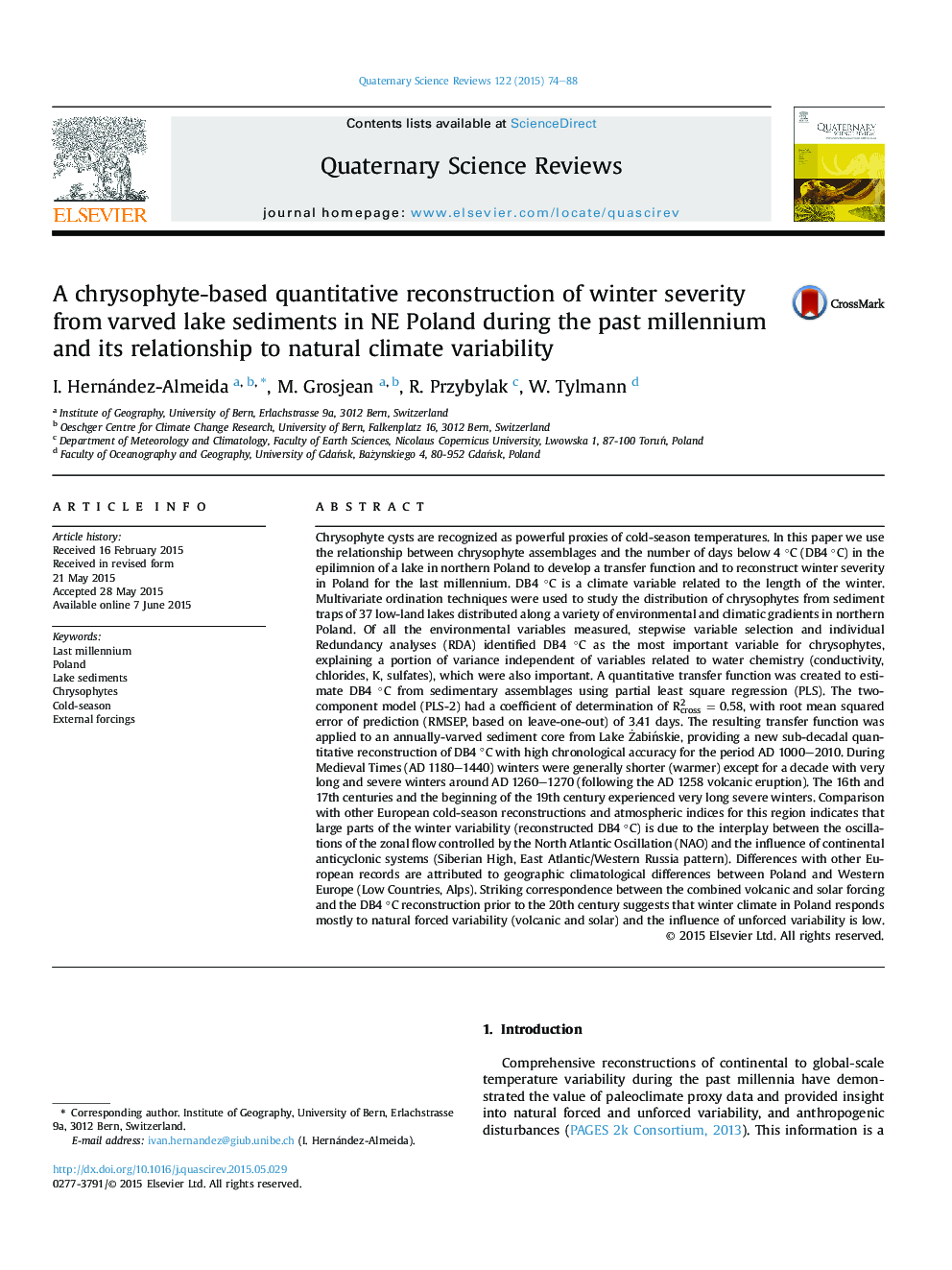| کد مقاله | کد نشریه | سال انتشار | مقاله انگلیسی | نسخه تمام متن |
|---|---|---|---|---|
| 6445854 | 1640812 | 2015 | 15 صفحه PDF | دانلود رایگان |
عنوان انگلیسی مقاله ISI
A chrysophyte-based quantitative reconstruction of winter severity from varved lake sediments in NE Poland during the past millennium and its relationship to natural climate variability
دانلود مقاله + سفارش ترجمه
دانلود مقاله ISI انگلیسی
رایگان برای ایرانیان
کلمات کلیدی
موضوعات مرتبط
مهندسی و علوم پایه
علوم زمین و سیارات
زمین شناسی
پیش نمایش صفحه اول مقاله

چکیده انگلیسی
Chrysophyte cysts are recognized as powerful proxies of cold-season temperatures. In this paper we use the relationship between chrysophyte assemblages and the number of days below 4 °C (DB4 °C) in the epilimnion of a lake in northern Poland to develop a transfer function and to reconstruct winter severity in Poland for the last millennium. DB4 °C is a climate variable related to the length of the winter. Multivariate ordination techniques were used to study the distribution of chrysophytes from sediment traps of 37 low-land lakes distributed along a variety of environmental and climatic gradients in northern Poland. Of all the environmental variables measured, stepwise variable selection and individual Redundancy analyses (RDA) identified DB4 °C as the most important variable for chrysophytes, explaining a portion of variance independent of variables related to water chemistry (conductivity, chlorides, K, sulfates), which were also important. A quantitative transfer function was created to estimate DB4 °C from sedimentary assemblages using partial least square regression (PLS). The two-component model (PLS-2) had a coefficient of determination of Rcross2 = 0.58, with root mean squared error of prediction (RMSEP, based on leave-one-out) of 3.41 days. The resulting transfer function was applied to an annually-varved sediment core from Lake Å»abiÅskie, providing a new sub-decadal quantitative reconstruction of DB4 °C with high chronological accuracy for the period AD 1000-2010. During Medieval Times (AD 1180-1440) winters were generally shorter (warmer) except for a decade with very long and severe winters around AD 1260-1270 (following the AD 1258 volcanic eruption). The 16th and 17th centuries and the beginning of the 19th century experienced very long severe winters. Comparison with other European cold-season reconstructions and atmospheric indices for this region indicates that large parts of the winter variability (reconstructed DB4 °C) is due to the interplay between the oscillations of the zonal flow controlled by the North Atlantic Oscillation (NAO) and the influence of continental anticyclonic systems (Siberian High, East Atlantic/Western Russia pattern). Differences with other European records are attributed to geographic climatological differences between Poland and Western Europe (Low Countries, Alps). Striking correspondence between the combined volcanic and solar forcing and the DB4 °C reconstruction prior to the 20th century suggests that winter climate in Poland responds mostly to natural forced variability (volcanic and solar) and the influence of unforced variability is low.
ناشر
Database: Elsevier - ScienceDirect (ساینس دایرکت)
Journal: Quaternary Science Reviews - Volume 122, 15 August 2015, Pages 74-88
Journal: Quaternary Science Reviews - Volume 122, 15 August 2015, Pages 74-88
نویسندگان
I. Hernández-Almeida, M. Grosjean, R. Przybylak, W. Tylmann,